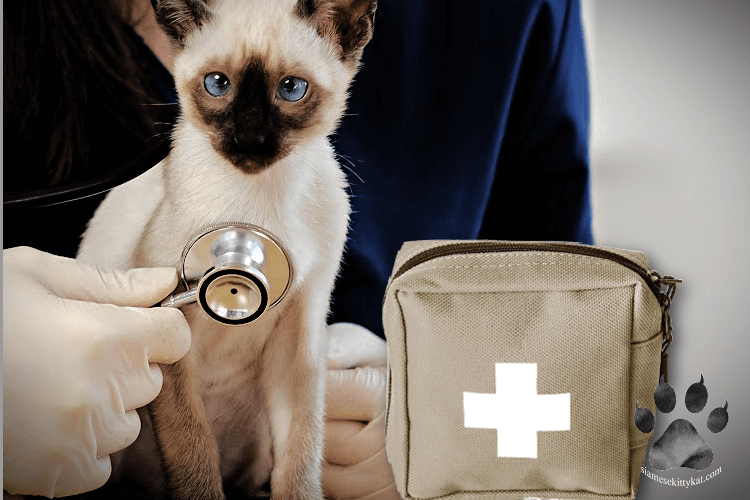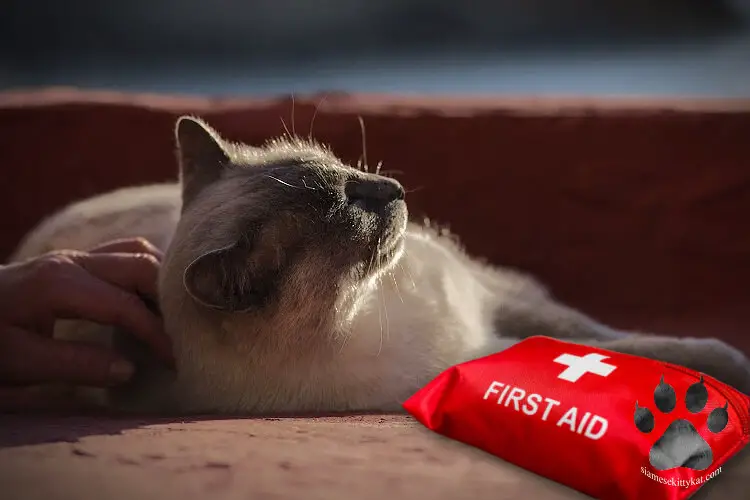Cats are beloved companions for millions of people around the world. Many cat owners even consider their furry friends to be family members. However, cats are small and agile animals and can get into accidents or fall ill.
You must be prepared for potential medical emergencies as a responsible cat owner. Some key things to look out for include
excessive bleeding, difficulty breathing, or severe pain or discomfort.
This article will discuss essential first-aid tips for dealing with Siamese cat emergencies.
You can give your Siamese cat the best care possible by following some simple guidelines.
What Should be in a DIY Cat First Aid Kit?
A DIY cat first aid kit should include various items to help you care for your pet in an emergency. Some of the essential items you should include are:
Other items that can be helpful to have on hand are:
You can clean wounds, control bleeding, and disinfect minor cuts with these items. Including your veterinarian’s phone number in your kit is also a good idea.
Batman, my adorable Siamese cat, is always getting into things he shouldn’t be. He’s my best friend, but he’s so mischievous! I have to be prepared for anything when I’m around him. That’s why I have a first aid kit, in case he gets hurt.
Where Should You Keep a Cat First Aid Kit?
A cat first aid kit should be kept in a safe, easily accessible place in your home. You should store it in a cool, dry place and out of reach of children and pets. It is also a good idea to keep a first aid kit in the car in case of an emergency.
How Do You Give Your Siamese Cat First Aid?

You can play a more active role in your cat’s medical care by treating minor injuries at home with this guide:
You must provide first aid as soon as possible if your Siamese cat has been injured.
First, assess the situation and determine whether your cat needs immediate medical attention. Take them to the vet right away if so. You can provide first aid yourself if the injury is not severe.
Start by gently cleaning the wound with warm water. You may use an antibiotic ointment to prevent infection.
Apply a sterile gauze pad to the wound and secure it with a bandage.
Apply pressure to the area with a clean cloth if the wound is bleeding heavily. Seek medical attention immediately if the bleeding does not stop.
Give your cat plenty of rest and keep them calm. Check the wound for redness, swelling, or discharge as these are possible signs of infection. Take your cat to the vet if you notice these signs.
Note:
You need to handle your cat with care if he has difficulty breathing. The best way to do this is to keep them calm and comfortable. Avoid anything that might aggravate their condition.
If you have to move them, do so slowly and gently, and make sure they have plenty of fresh air.
Seek veterinary attention if their condition worsens, or they show other signs of distress.
How Do You Transport an Injured Cat?
There are a few things to keep in mind when driving to the vet with your cat. First, be sure to drive carefully. Your cat may be feeling anxious and stressed, and the last thing you want is for them to get injured in an accident.
Second, keep your cat in a closed box or carrier while transporting them. This will help to keep them safe and secure and will also help to lower their stress levels.
How Do Cats Act When They’re Injured?
Cats tend to hide their pain. This instinct makes it difficult to assess the severity of an injury and can delay treatment.
Cats are very good at masking their pain; thus, you should be observant. Look for subtle behavioral changes that may show discomfort.
Some signs could indicate your cat is in pain or injured:
The best thing to do if you spot an injury is call your veterinarian right away.
Even the most minor ones can be more complicated than they seem. With cats, in particular, it can be hard to tell how much pain they’re in. So, getting medical help as soon as possible will help them heal faster.
How Do You Take Care of a Cat’s Wound?

Licking and scratching can irritate a wound and delay healing. Follow your vet’s instructions carefully and monitor your cat’s wound closely. Your vet may recommend using an E-collar to keep your cat from licking or scratching her wound.
You may need to change your cat’s bandages regularly to ensure they stay clean and dry. Wet or dirty bandages may become uncomfortable and irritate your cat’s skin.
Also, check if your cat’s bandages or wrappings are swelling. Severe swelling might mean the bandages are too tight and need to be adjusted. However, you should never remove the bandages unless your veterinarian says it’s okay to do so.
Follow the directions on any medications prescribed for your injured cat. Giving a cat human medicines is a bad idea and can be extremely dangerous. Cats are much smaller than humans, and their bodies process medication differently. What may be a safe dosage for a human could be toxic for a cat.
What Should I Feed my Injured Cat?
Your Siamese cat’s injury will need some special attention when it comes to its diet. You’ll want to look for food that is high in protein and fat, as well as vitamins and minerals. Avoid foods high in sugar or carbohydrates, as these can hinder healing. Your Siamese cat will be on the road to recovery in no time with proper nutrition!
How Can You Tell if Your Cat is Hurt Internally?
A few signs may indicate that a cat has sustained internal injuries. These include:
You may see your cat crying out, hunched over, or guarding its abdomen if he is in pain.
Your cat may also have swelling or bruising around the site of the injury after suffering from a traumatic injury.
Seek veterinary care right away, as internal injuries can be very serious.
Can a Cat Survive Internal Injuries?
Internal injuries are severe and can be life-threatening. Your cat will need immediate veterinary care if he has suffered from internal injuries. The prognosis for a cat with internal injuries depends on the severity of the injuries and how fast they receive treatment.
In some cases, a cat may be able to recover from internal injuries with proper medical treatment. However, in other cases, the injuries may be too severe, and the cat may not be able to survive.
No one ever wants to think about their pet being in an emergency, but you should be prepared just in case. The best action to take in any emergency situation is to contact your veterinarian.
Make sure you know the name and phone number of your local veterinary office. This way, you can get in touch with them right away if you need to.
We gathered all the health tips tailored towards maintaining your Siamese cat’s optimal well-being. Check it out here: Siamese Cat Health: A Complete Guide
